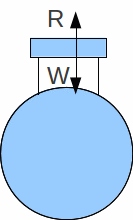Newton's third law states:
To every action there is an equal and opposite reaction.
Newton's third law implies that forces always come in pairs. In fact, these force pairs have the same origin and nature. If one is gravitational, then so is the other; if one is electric then so is the other. The forces of Newton's third law have the same magnitude and act along the same line but in opposite directions. In addition to this, the two forces act on different bodies.

The bodies do not need to be in contact for the third law to apply. The masses above, exerting gravitational forces on each other, are not in contact for example.

In fact W is the force exerted on the books by the Earth, and the book pulls upwards on the Earth with an equal force. These forces are force pairs in the sense of Newton's third Law.
R is the reaction of the table on the book, produced by electrostatic repulsion between the electron clouds between the surface atoms of the book and the table. In return the book pushes down on the table with an equal force, and this force has the same origin – electrostatic repulsion between electron clouds in the surface atoms of the book and table. These are a force pair in the sense of Newton's third law.
